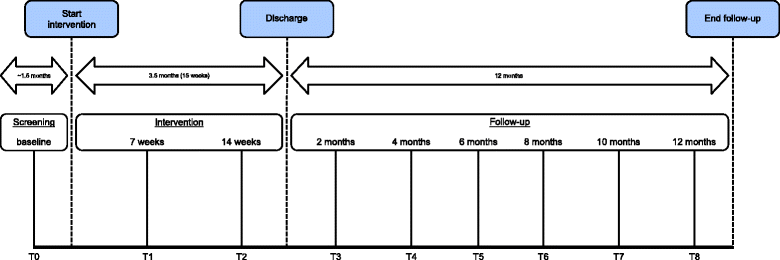Cost-effectiveness of 40-hour versus 100-hour vocational rehabilitation on work participation for workers on sick leave due to subacute or chronic musculoskeletal pain: study protocol for a randomized controlled trial
- PMID: 26215748
- PMCID: PMC4518875
- DOI: 10.1186/s13063-015-0861-4
Cost-effectiveness of 40-hour versus 100-hour vocational rehabilitation on work participation for workers on sick leave due to subacute or chronic musculoskeletal pain: study protocol for a randomized controlled trial
Abstract
Background: Although vocational rehabilitation is a widely advocated intervention for workers on sick leave due to subacute or chronic nonspecific musculoskeletal pain, the optimal dosage of effective and cost-effective vocational rehabilitation remains unknown. The objective of this paper is to describe the design of a non-inferiority trial evaluating the effectiveness and cost-effectiveness of 40-h multidisciplinary vocational rehabilitation compared with 100-h multidisciplinary vocational rehabilitation on work participation for workers on sick leave due to subacute or chronic musculoskeletal pain.
Methods/design: A non-inferiority study design will be applied. The study population consists of workers who are on part-time or full-time sick leave due to subacute or chronic nonspecific musculoskeletal pain. Two multidisciplinary vocational rehabilitation programs following the bio-psychosocial approach will be evaluated in this study: 40-h vocational rehabilitation and 100-h vocational rehabilitation, both delivered over a maximum of 15 weeks. The 100-h vocational rehabilitation comprises five modules: work participation coordination, graded activity, cognitive behavioral therapy, group education, and relaxation. The 40-h vocational rehabilitation comprises work participation coordination and a well-reasoned choice from the other four modules. Four rehabilitation centers will participate in this study, each delivering both interventions. Patients will be randomized into one of the interventions, stratified for the duration of sick leave (<6 weeks or ≥ 6 weeks) and type of sick leave (part-time or full-time). The primary outcome is work participation, measured by self-reported sick leave days, and will be assessed at baseline, mid-term, discharge, and at 2, 4, 6, 8, 10, and 12 months follow-up. Secondary outcomes are work ability, disability, quality of life, and physical functioning and will be assessed at baseline, discharge, and at 6 and 12 months follow-up. Cost outcomes are absenteeism, presenteeism, healthcare usage, and travelling costs. Cost-effectiveness will be evaluated from the societal and employer perspectives.
Discussion: The results obtained from this study will be useful for vocational rehabilitation practice and will provide stakeholders with relevant insights into two versions of vocational rehabilitation.
Trial registration: Dutch Trial Register identifier: NTR4362 (registered 17 March 2014).
Figures
Similar articles
-
The effectiveness of the "Brainwork Intervention" in reducing sick leave for unemployed workers with psychological problems: design of a controlled clinical trial.BMC Public Health. 2015 Apr 14;15:377. doi: 10.1186/s12889-015-1728-z. BMC Public Health. 2015. PMID: 25887217 Free PMC article. Clinical Trial.
-
Cost-effectiveness of a participatory return-to-work intervention for temporary agency workers and unemployed workers sick-listed due to musculoskeletal disorders: design of a randomised controlled trial.BMC Musculoskelet Disord. 2010 Mar 28;11:60. doi: 10.1186/1471-2474-11-60. BMC Musculoskelet Disord. 2010. PMID: 20346183 Free PMC article. Clinical Trial.
-
Integrated mental health care and vocational rehabilitation to improve return to work rates for people on sick leave because of exhaustion disorder, adjustment disorder, and distress (the Danish IBBIS trial): study protocol for a randomized controlled trial.Trials. 2017 Dec 2;18(1):579. doi: 10.1186/s13063-017-2273-0. Trials. 2017. PMID: 29197404 Free PMC article. Clinical Trial.
-
The effects of timing on the cost-effectiveness of interventions for workers on sick leave due to low back pain.Occup Environ Med. 2010 Nov;67(11):744-50. doi: 10.1136/oem.2009.049874. Epub 2010 Sep 10. Occup Environ Med. 2010. PMID: 20833757 Review.
-
Vocational rehabilitation programs for individuals with chronic arthritis.Curr Opin Rheumatol. 2009 Mar;21(2):183-8. doi: 10.1097/BOR.0b013e328324e6eb. Curr Opin Rheumatol. 2009. PMID: 19339931 Review.
Cited by
-
Measurement Properties of the Work Ability Score in Sick-Listed Workers with Chronic Musculoskeletal Pain.J Occup Rehabil. 2022 Mar;32(1):103-113. doi: 10.1007/s10926-021-09982-7. Epub 2021 May 26. J Occup Rehabil. 2022. PMID: 34037926
-
Dutch Dataset Vocational Rehabilitation for Chronic Musculoskeletal Pain: Baseline Patients' Characteristics and Program Eligibility.J Occup Rehabil. 2025 Jun;35(2):278-287. doi: 10.1007/s10926-024-10207-w. Epub 2024 Jun 4. J Occup Rehabil. 2025. PMID: 38833120
-
Vocational Rehabilitation for Patients with Chronic Musculoskeletal Pain With or Without a Work Module: An Economic Evaluation.J Occup Rehabil. 2021 Mar;31(1):84-91. doi: 10.1007/s10926-020-09921-y. J Occup Rehabil. 2021. PMID: 32816203 Free PMC article.
-
Methodological and interpretive concerns about Beemster et al.'s article 'The interpretation of change score of the pain disability index after vocational rehabilitation is baseline dependent': a letter to the editor.Health Qual Life Outcomes. 2020 Sep 7;18(1):301. doi: 10.1186/s12955-020-01555-1. Health Qual Life Outcomes. 2020. PMID: 32894135 Free PMC article.
-
The interpretation of change score of the pain disability index after vocational rehabilitation is baseline dependent.Health Qual Life Outcomes. 2018 Sep 14;16(1):182. doi: 10.1186/s12955-018-1000-1. Health Qual Life Outcomes. 2018. PMID: 30217206 Free PMC article.
References
-
- Bekkering GE, Bala MM, Reid K, Kellen E, Harker J, Riemsma R, et al. Epidemiology of chronic pain and its treatment in The Netherlands. Neth J Med. 2011;69:141–53. - PubMed
-
- de Vroome EM, Uegaki K, van der Ploeg CP, Treutlein DB, Steenbeek R, de Weerd M, et al. Burden of sickness absence due to chronic disease in the Dutch workforce from 2007 to 2011. J Occup Rehabil. 2015. [epub ahead of print.] - PubMed
Publication types
MeSH terms
Associated data
LinkOut - more resources
Full Text Sources
Other Literature Sources
Medical



